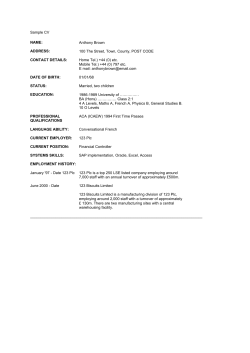
y Ohio Energ Workshop L
Ohio Energy Workshop L PJM Capacity … Unpacking the Issues and Developing Cost Management Strategies Tuesday, February 18, 2014 1:45 p.m. to 3 p.m. Biographical Information Ritesh Tipnis Manager, Products AEP Energy 225 West Wacker, Suite 700, Chicago IL 60606 312-488-5020 Fax: 312-488-5021 rtipnis@aepenergy.com Dr. Ritesh Tipnis is the Product Manager in AEP Energy’s Product’s Team, and is responsible for developing, launching and supporting the Company’s products and services, including PJM and other RTO related programs. Prior to joining AEP Energy in 2011, Ritesh was a Program Manager at a Printed Electronics company, Plextronics Inc. in Pittsburgh, where he led the organizations Product Engineering team focused on developing Photovoltaic Product offering. A graduate of University Of Connecticut’s Ph.D. program in Polymer Science, Dr. Tipnis has numerous publications and presentations at symposiums and conferences organized by agencies such as Department of Energy and Department of Defense. PJM Capacity…Unpacking the Issues and Developing Cost Management Strategies February 18th, 2014 2/4/2014 AEP Energy is a competitive retail electric service provider affiliated with American Electric Power, Inc. AEP Energy is not soliciting on behalf of and is not an agent for any AEP utility. CONFIDENTIAL Copyright © AEP Energy, Inc. All Rights Reserved. American Electric Power, Inc. • AEP Energy is a wholly owned subsidiary of American Electric Power Co., Inc. (AEP) • AEP is one of the largest electric utilities in the U.S., delivering electricity to more than 5 million customers in 11 states • A Fortune 200 company headquartered in Columbus, Ohio, founded in 1906, with ~23 billion market cap • The largest electricity transmission system in the U.S. & one of the nation’s largest generators of electricity AEP Energy A competitive supplier of power and energy management since 2002, we serve more than 200,000 customers and operate across the US. 2/4/2014 Copyright © AEP Energy, Inc. All Rights Reserved. It’s More than Just Price USAGE PRICE Demand Energy Gas Capacity Transmission Supply Distribution Gas Permanently Reduced Operating Costs Improves Your Bottom Line • Energy Conservation can be considered a resource with financial value • Improved efficiency addresses all of the cost components that go into an energy bill through: o Reduced demand (kW) o Reduced usage (kWh) 2/4/2014 Copyright © AEP Energy, Inc. All Rights Reserved. Power Cost Breakdown • Typical Electricity Bill Cost Components • Smart procurement can only address ~54% of total cost. • Energy Management addresses all energy bill determinants: o Permanent load destruction (kW): Transmission (NSPL) Capacity (PLC) Distribution (peak billing demand) • Sample customer in Columbus Southern service territory, GS3 rate, deregulated supply, load factor of 70%. • Based on 2014/15 rates 2/4/2014 o Reduced energy usage (kWh): Energy & Ancillaries o Reduced Natural Gas usage: MMBTU Copyright © AEP Energy, Inc. All Rights Reserved. Capacity Cost Management - PJM • Capacity costs are based on Capacity Prices and the Capacity Peak Load Contribution (PLC) assigned to each customer o PLCs are determined based on average customer usage over PJM’s five Coincident (meaning system wide, all load coming on coincidentally together) Peaks (5CPs) Day Thursday Friday Wednesday Tuesday Monday 2/4/2014 Date 7/18/2013 7/19/2013 7/17/2013 7/16/2013 7/15/2013 Hour (EPT) 17:00 15:00 17:00 17:00 18:00 MW 158,953 156,085 154,070 151,439 150,726 Copyright © AEP Energy, Inc. All Rights Reserved. 5 PJM Capacity Trends • • The capacity rates in AEP show a modest increase from 2014/15 to 2015/16, but in ATSI there is an increase by almost 130% The rates decrease significantly in 2016/17 2/4/2014 Copyright © AEP Energy, Inc. All Rights Reserved. Capacity Cost Management • Peak Load (PLC) Management o Reduce Capacity costs by reducing PLCs Capacity Cost reductions start in following delivery year o Reduce PLCs by reducing load during Coincident Peak • Emergency Capacity Demand Response (DR) o Receive payments to curtail load when called upon Payments start in fall of the current delivery year, after summer curtailment period o Payments to Curtailment Services Provider (CSP) from PJM. Typically passed through to Customer under DR contract. o Offset but not equal to capacity costs 2/4/2014 Copyright © AEP Energy, Inc. All Rights Reserved. 7 Emergency Demand Response • • • The market clearing price (MCP) is set through a Base Residual Auction (BRA) process, three years in advance of the delivery year (DY) There are subsequent 3 ‘sell’ and ‘buy’ incremental auctions Starting DY 2014/15 there are 3 main DR products o Limited – June-Sept (any weekday other than NERC holidays), up to 10 interruptions of for up to 6 hours o Extended Summer – June-Oct and following May, unlimited interruptions for up to 10 hours o Annual DR – Any day (unless on an approved maintenance outage during Oct-Apr), unlimited interruptions for up to 10 hours 2/4/2014 Copyright © AEP Energy, Inc. All Rights Reserved. 8 PJM DR BRA Clearing Price (Limited Product) AEP: Ext. & Ann.: $136 ATSI: Ext.: $322.08 ATSI Ann.: $357 Extended & Annual: $125.99 2/4/2014 AEP: Ext. & Ann.: $59.37 ATSI: Ext. & Ann.: $114.23 Copyright © AEP Energy, Inc. All Rights Reserved. Demand Response in BRA 2/4/2014 Copyright © AEP Energy, Inc. All Rights Reserved. Emergency Events in 2013 Monday Tuesday Thursday 7/15/2013 7/16/2013 7/18/2013 Tuesday 9/10/2013 Wednesday 9/11/2013 2/4/2014 Notification 13:50 11:30 12:40 13:00 13:50 14:45 11:30 12:00 Start Release 15:50 13:30 14:40 15:00 15:50 16:45 13:30 14:00 Copyright © AEP Energy, Inc. All Rights Reserved. 18:22 16:30 18:00 18:00 21:30 21:30 19:30 20:00 AEP (Partial) Date AEP Day ATSI Time (EPT) Capacity Cost Management Options DR Curtailment Quantity DR Auction Clearing Price DR Revenue PLC Management PLC Mitigation 2/4/2014 PJM Capacity Price Cost Reduction Copyright © AEP Energy, Inc. All Rights Reserved. 12 Capacity Cost Mitigation – PLC PLC Mitigation PLC Reduction • Equal to : • Avoided PLC – Actual PLC • Avoided PLC is load during 5 CPs without any action taken • • • • Zonal Scaling Factor (ZSF) • Set by PJM to account for load growth Forecast Pool Requirement • Set by PJM to Account for Reserve requirements PLC Mitigation • Applied against RPM Auction Clearing Price to determine revenue Customer reduces load when a Coincident Peak event is forecast Total impact will be average of load reduction for each of 5 CP events PLC Reduction will take effect the following Delivery Year No penalty for non-performance 2/4/2014 Copyright © AEP Energy, Inc. All Rights Reserved. 13 Capacity Cost Management – DR Curtailment Quantity • • • • • Load Curtailed DR Factor • Equal to : • PLC ‐ Firm Service Level (FSL) • FSL is the maximum load customer will draw during test or curtailment event • Set by PJM to determine the reliability benefit of demand resource and to assign an appropriate value to demand resource products Forecast Pool Requirement • Set by PJM to Account for Reserve requirements Curtailment Quantity • Applied against DR Auction Clearing Price to determine revenue Customer nominates FSL when enrolling into DR program Customer is required to drop load to FSL whenever PJM calls a DR Event: PJM may call up to 6 Emergency Events, each up to 10 hours in duration each year from June through September (Limited Product) If no Emergency event is called, then PJM will call a Test Event Non-performance penalties of up to 20% of expected payment 2/4/2014 Copyright © AEP Energy, Inc. All Rights Reserved. 14 Capacity Cost Management Auction Clearing Prices & Final Price to Capacity Delivery Year (AEP Example) • • • BRA* Clearing Price for Limited Demand Resources (DR) ‐ $/MW‐Day BRA Clearing Price for Other Resources** $/MW‐Day Final PJM Price to Capacity*** 2014‐15 $125.47 $125.99 $129.28 2015‐16 $118.54 $136.00 $135.72 2016‐17 $59.37 $59.37 $59.37 $/MW‐Day * BRA is Base Residual Auction, conducted 3 years in advance of delivery year. This is the first – and largest – of four auctions that PJM conducts to manage overall capacity requirements. A significant majority of resources are cleared in the BRA, and Final Price largely reflects BRA Pricing. Clearing Price for Limited Demand Resources is what is paid to DR resources that agree to curtail up to 60 hours per year (Limited availability). ** These are prices paid to generation and other resources that do not have the same limits as Limited DR resources. *** Final prices represent a blend of Limited and Other Resource prices, with results of other all auctions factored in. This is the price charged to load in the actual Delivery Year. 2/4/2014 Copyright © AEP Energy, Inc. All Rights Reserved. 15 Capacity Cost Management Examples: For 1MW curtailment in AEP (2015/16) DR Curtailment Quantity Example: 1.042 MW Ltd. DR Auction Clearing Price (x Days) DR Revenue $118.54/MW-Day (x 366) = X $45,208 (after applying FPR, and DR Factor for current year) PLC Management PJM Capacity Price (x Days) PLC Mitigation Example: 1.15 MW X Cost Reduction $135.72/MW-Day (x 366) = $57,125 (after applying FPR, and ZSF current year) 2/4/2014 Copyright © AEP Energy, Inc. All Rights Reserved. 16 Capacity Cost Management Summary & Key Differences Component Quantity Price Payment Non-performance 2/4/2014 PLC Management DR Notes Based on reducing load during 5 Coincident Peak (CP) events Based on amount agreed to curtail for up to 60 hours per season PLC events based on forecast from service provider. DR events are called by PJM. Based on Final Capacity Prices Based on BRA or IA for Limited DR Final Prices tend to end up higher, up to 10% higher in recent history Takes effect in delivery year following load reduction. Must be coordinated with Retail Supplier Takes effect in fall of current delivery year. Must be arranged with Capacity Services Provider (CSP) One year lag/continuation for PLC Management No penalties Up to 20% Copyright © AEP Energy, Inc. All Rights Reserved. 17 Capacity Cost Management via Data Analytics Ok, we want to do something but What’s next? • “What gets measured, gets managed…gets improved” – Peter Drucker • “I never guess. It is a capital mistake to theorize before one has data. Insensibly one begins to twist facts to suit theories, instead of theories to suit facts” - Sir Arthur Conan Doyle • “If you torture the data long enough, it will confess” - Ronald Coase 2/4/2014 Copyright © AEP Energy, Inc. All Rights Reserved. 18 Data Analytics • Interval Data o Forest v. Trees • Heat Maps o Show overall operating pattern and performance • Duration Curves o Show peak demands, operating levels, operating configurations o Allow for review of Distribution Demand management, capacity and transmission cost reductions, demand response and ECMs • Typical Periods o Provide views of connected loads and operating schedules • Predictive Analysis o Interval independent variable analysis 2/4/2014 Copyright © AEP Energy, Inc. All Rights Reserved. 19 Interval Data Deep Dive • Weather Sensitive Loads o Utilize hourly weather data – dry bulb temperature, humidity, wind speed, wind direction, solar gain, precipitation o Hourly (or less) load response • Hourly Sensitivities and Drivers o Production and weather o Correlations and coefficients can be used to flag system issues and performance o Performance can be linked back to specific Energy Conservation Measures o Data can be used for measurement and verification • Compare Service/Production Data with Energy Usage 2/4/2014 Copyright © AEP Energy, Inc. All Rights Reserved. 20 Load Duration Curve • • • 2/4/2014 Region 1 – Controllable Load to shave peak demand Region 2 - Potential for Interruptible load Region 3 – Energy Efficiency for permanent demand reduction Copyright © AEP Energy, Inc. All Rights Reserved. 21 Hourly Load during 2013 Capacity setting days in AEP Management of load during 5 Capacity peaks can lead to a reduction in capacity costs for the following year 2/4/2014 Copyright © AEP Energy, Inc. All Rights Reserved. Heat Map • • 2/4/2014 Show overall operating pattern and performance Determine off-hour usage Copyright © AEP Energy, Inc. All Rights Reserved. 23 How do we use these tools? • Understand customer’s usage patterns • Identify opportunities for capacity management • Implement executable actions 2/4/2014 Copyright © AEP Energy, Inc. All Rights Reserved. 24 Heat Maps Customer is managing capacity costs 2/4/2014 Copyright © AEP Energy, Inc. All Rights Reserved. 25 Customer Profile - A • Increased usage during CP setting/Potential DR hours • Possibility to shift load 2/4/2014 Copyright © AEP Energy, Inc. All Rights Reserved. 26 Customer Profile - B • Flat load over a 24 hour period • Limited opportunity to curtail 2/4/2014 Copyright © AEP Energy, Inc. All Rights Reserved. 27 Customer Profile - C • The load profile seems to indicate heavy usage during the evening hours • The nature of the business may not render curtailment as an option 2/4/2014 Copyright © AEP Energy, Inc. All Rights Reserved. 28 Summary • Capacity Prices in PJM are based on customers PLC • There are a couple of ways through which a customer can manage or offset their capacity costs – PLC Mitigation and Demand Response • Data Analytics can help design curtailment strategies to maximize profitability 2/4/2014 Copyright © AEP Energy, Inc. All Rights Reserved. 29 Questions and Follow Up Ritesh Tipnis, Ph.D. Manager, Products AEP Energy (312) 488-5020 rtipnis@aepenergy.com Special thanks to the Energy Management Team at AEP Energy, especially Scott Slisher, George Deljevic and Jacob Stoll 2/4/2014 Copyright © AEP Energy, Inc. All Rights Reserved. 30
© Copyright 2025










